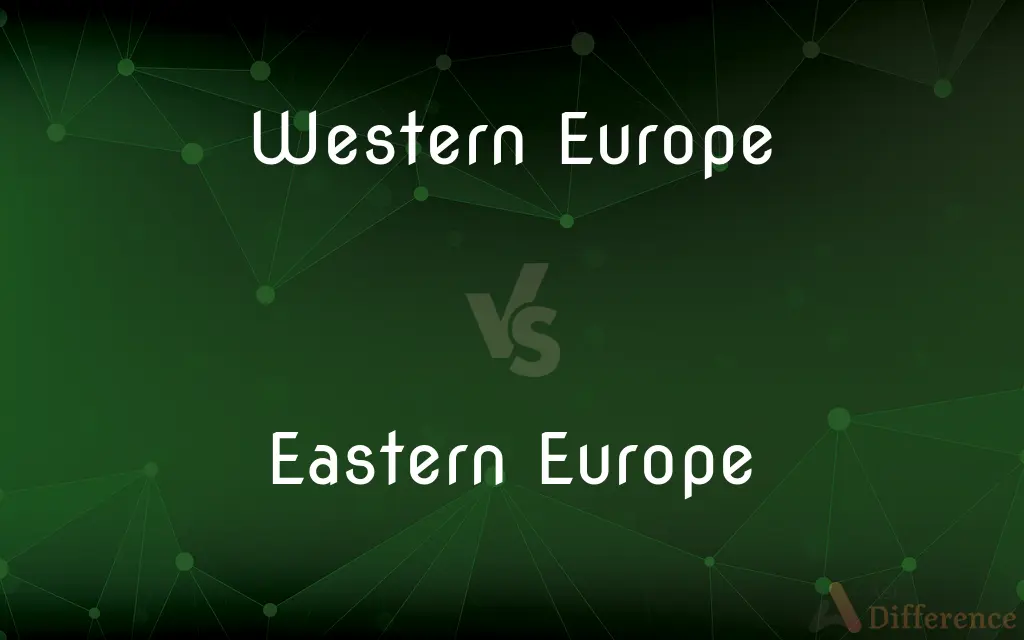Western Europe vs. Eastern Europe — What's the Difference?
By Tayyaba Rehman — Published on October 30, 2023
Western Europe typically associates with higher economic development and is often influenced by Roman law, while Eastern Europe has been historically shaped by Byzantine and Ottoman empires and often entails different socio-political contexts.

Difference Between Western Europe and Eastern Europe
Table of Contents
ADVERTISEMENT
Key Differences
Western Europe often implies countries with relatively high GDP per capita, strong economies, and a significant influence on global affairs. Eastern Europe, while also containing economically strong nations, has historically experienced different economic trajectories, often influenced by socialist governance structures in the 20th century.
Culturally, Western Europe has its roots deeply embedded in Roman and Frankish civilizations, coloring its languages, legal systems, and cultural practices. Eastern Europe, conversely, experienced the pervasive influences of the Byzantine Empire and later, the Ottoman Empire, providing a different cultural and religious milieu.
The European Union (EU) has been more quickly and broadly embraced in Western Europe, with countries being founding members or early joiners. Eastern Europe has seen its countries join the EU more recently, with some still not being members, reflecting different political and economic integrations and alliances.
In terms of the geopolitical landscape, Western Europe has been fundamentally allied with the North Atlantic Treaty Organization (NATO) since its inception. Meanwhile, Eastern Europe has seen a more varied history with military alliances, such as the past Warsaw Pact, and varying relations with NATO.
Linguistically, Western Europe is characterized by Romance, Germanic, and some Celtic languages, indicative of the historical influences of the Roman Empire. Eastern Europe displays a tapestry of Slavic languages, interspersed with non-Slavic languages, reflecting its diverse and complex historical influences.
ADVERTISEMENT
Comparison Chart
Cultural Influences
Roman and Frankish
Byzantine and Ottoman
Economic History
Capitalist traditions
Socialist histories
EU Membership
Earlier and Founding Members
Generally later joiners
Military Alliances
Consistently NATO-aligned
Varied historical alliances
Language Families
Primarily Romance and Germanic
Predominantly Slavic
Compare with Definitions
Western Europe
Western Europe frequently identifies with Roman and later, Western Christian influence.
Italy in Western Europe was the epicenter of the Roman Empire.
Eastern Europe
Eastern Europe identifies with a rich history affected by Byzantine and Ottoman rule.
Bulgaria, in Eastern Europe, fell under the sphere of both Byzantine and Ottoman influences.
Western Europe
Western Europe is often recognized for establishing and expanding the European Union.
Belgium, located in Western Europe, was a founding member of the European Union.
Eastern Europe
Eastern Europe has displayed varied affiliations with military alliances across history.
Hungary, in Eastern Europe, was a member of the Warsaw Pact during the Cold War.
Western Europe
Western Europe typically affiliates with NATO since its inception.
The United Kingdom, despite its geographic position, is often included in discussions about Western Europe due to its NATO alignment and socio-political leanings.
Eastern Europe
Eastern Europe encompasses nations that had divergent paths to EU membership.
Romania, in Eastern Europe, joined the European Union in 2007.
Western Europe
Western Europe often embodies countries with economies that are well-developed.
Germany, in Western Europe, boasts one of the largest economies in the world.
Eastern Europe
Eastern Europe often encompasses countries with varied economic structures and histories.
Poland in Eastern Europe experienced a socialist government post-World War II.
Western Europe
Western Europe is commonly associated with Romance and Germanic languages.
French, a Romance language, is widely spoken in Western Europe.
Eastern Europe
Eastern Europe is primarily associated with countries where Slavic languages are spoken.
The Czech Republic, in Eastern Europe, has Czech, a Slavic language, as its official language.
Common Curiosities
Why is there an economic disparity between Western Europe and Eastern Europe?
Historical, political, and social factors, including the impacts of WWII and the Cold War, contribute to economic disparities between Western and Eastern Europe.
Is Russia considered part of Eastern Europe?
Yes, Russia is generally considered part of Eastern Europe, particularly the areas west of the Ural Mountains.
Is Greece considered in Western or Eastern Europe?
Geographically in the south, Greece is often associated with Western Europe due to its early democratic history, yet shares many cultural aspects with Eastern Europe.
Why do some countries in Eastern Europe have Cyrillic alphabets?
The adoption of the Cyrillic alphabet in some Eastern European countries is largely due to the influence of the Orthodox Christian Byzantine Empire.
Which Western European countries were original EU members?
Western European countries like Belgium, Germany, France, and Italy were among the original EU members.
What are the major languages spoken in Eastern Europe?
Slavic languages like Russian, Polish, and Czech are major languages in Eastern Europe.
What is the Schengen Area and which Western European countries are members?
The Schengen Area allows for passport-free travel across many European countries. Western European members include France, Germany, and Spain, among others.
What countries are typically considered Western Europe?
Countries like Germany, France, and the United Kingdom are often categorized as Western Europe.
How does the educational system vary between Western and Eastern Europe?
While there are individual country variations, Western Europe often emphasizes liberal arts education, while Eastern Europe has historically had a strong focus on specialized and technical training.
Why are some Eastern European nations not part of the European Union?
Various reasons, including economic readiness, political willingness, and meeting specific EU criteria, affect some Eastern European countries' non-membership.
What is the historical significance of the Iron Curtain in relation to Western and Eastern Europe?
The Iron Curtain symbolized the ideological and physical boundary dividing Soviet-influenced Eastern Europe from the democratic and capitalist Western Europe during the Cold War.
Are there significant climate differences between Western and Eastern Europe?
Both regions exhibit varied climates, but broadly, Western Europe tends to be milder and wetter due to Atlantic influences, while Eastern Europe can experience more extreme seasonal variations.
How did WWII impact the division between Western and Eastern Europe?
Post-WWII, Eastern Europe was significantly influenced by the Soviet Union, creating a socio-political divide from the capitalist West, solidifying distinctions between Western and Eastern Europe.
How does the cost of living compare between Western and Eastern Europe?
Generally, Western Europe tends to have a higher cost of living compared to Eastern Europe, reflecting economic disparities and varied living standards between them.
What role does religion play in the cultural differences between Western and Eastern Europe?
Western Europe, under Roman influence, predominantly adopted Roman Catholicism or Protestantism, while Eastern Europe often adhered to Orthodox Christianity due to Byzantine influence.
Share Your Discovery

Previous Comparison
Trial Balance vs. Balance Sheet
Next Comparison
All The Best vs. Best Of LuckAuthor Spotlight
Written by
Tayyaba RehmanTayyaba Rehman is a distinguished writer, currently serving as a primary contributor to askdifference.com. As a researcher in semantics and etymology, Tayyaba's passion for the complexity of languages and their distinctions has found a perfect home on the platform. Tayyaba delves into the intricacies of language, distinguishing between commonly confused words and phrases, thereby providing clarity for readers worldwide.












































